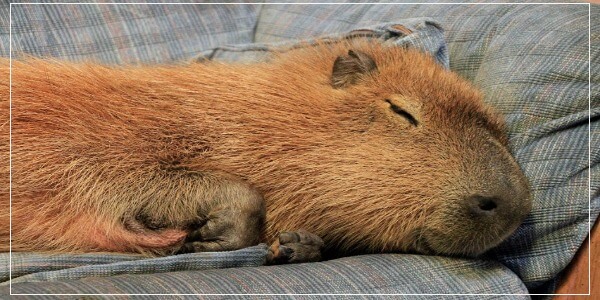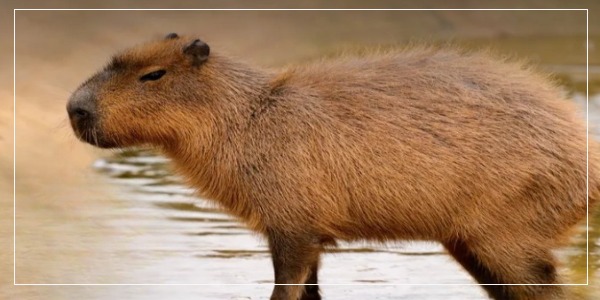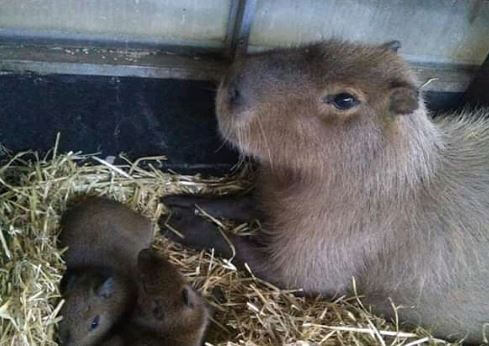Capybaras are giant sociable animals, described as cousins to the guinea pigs, which can sometimes mature to pretty impressive weights of up to about 170 pounds or more.
They have the scientific name Hydrochoerus hydrochaeris, with a life expectancy of between two years to one decade. Their relatively large size implies that they require lots of space and, of course, an accessible water source.
They thrive as pets, mostly in groups. How do you house-train such creatures?
Since they are relatively sociable by living in groups, it should be somewhat easy to tame them. In order to house train them, we must know certain basic things about them, such as their overall characteristics, specie information, likely differences (if any), feeding habits, shelter, health challenges, breeding, places of purchase, and so on.
Knowing these necessities will enable you to know how effectively you can tame and train them at home. Otherwise, any attempt at home training a capybara may not yield the desired results.
In the course of this article, we shall discuss all those areas of primary concern in a step-step process so as to regale you with the facts you must be equipped with to succeed.
Capybara Behaviors And Temperaments
These cute animals are adjudged to be quite tamable. However, if you intend to get a fully grown capybara for a pet, you have to be a little more patient with it until such a time when it will eventually get used to you.
They do not have such a fearful propensity for violence, but they may bite using their giant teeth in self-defense when they feel threatened.
Taming a capybara should be a slow process during which the animal would move slowly but, most certainly, warms up to you. Advisedly, gently comb them as you offer food, which can elicit a relaxing and bonding attachment with you.
However, capybaras must be kept in pairs because they hardly thrive when kept alone, but don’t allow the males to live exclusively together, even when neutered, lest you evoke territorial fights.

To guard against this, they must not be confined to a small space where you have many males. The males bear scent glands on top of their snouts, which are essentially used to mark out their territories, and the females have too, but theirs are not actually visible.
They can also mark these territories they claim with their anal glands.
These giant rodents are vocal with each other. The capybaras must live near a regular water source because they have dry skin requiring constant hydration. Their feet are webbed, so they are excellent swimmers who can hold their breath underwater for a couple of minutes.
They prefer a habit of clumps of grasses, which they use as food and also to hide from predators. To regulate their body temperatures and prevent sunburn, since they have sparse furs and few sweat glands, they do cover themselves in mud, just like pigs do.
Communication With Capybaras
These weird animals are quite sociable and communicate with one another through a variety of sounds in what should aptly be described as vocalization.
They do this with the aid of their purrs, barks, grunts, whistles, squeaks, coughs, and many other ways. It is thus easy to see why a capybara kept in isolation will likely suffer stress and depression from which it may never survive.
Proper house training may necessitate you to mimic such sounds to assure your capybara. The best assurance, however, is to make certain that your capybara has at least one companion to keep it company and grow together with.
DON’T MISS: Before Bringing A Capybara Home – Here Are Things You Must Do
The Housing Of The Capybara
The fact that the capybaras are social giant rodents demands that you should not keep them in solitary housing; for this reason, you need to make plenty of space available for the family.
Preferably a wide fenced enclosure that will allow roughly 12 feet by 20 feet for each pair and a secure pace for them to wander around at night. The surrounding fence should be as high as 4 feet or even more and ensure that there are no gaps or spaces through which they can squeeze their way out.
Finally, there should be a water pool nearby, which, along with a shaded area, must always be accessible. Untreated wood, dog toys, or some similar items can be scattered around for the capybaras to bot chew on and float with on the water.
The capybaras are basically diurnal creatures; for that reason, they require daily exposure to sunlight and are known to prefer warm weather.
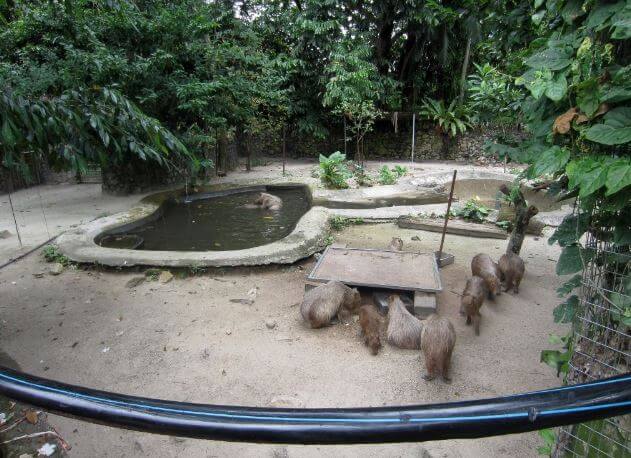
Usually, they need watering holes to cool off on hot days. When temperatures become too cold, they retreat indoors until the cold season abates. However, in situations where indoor temperatures themselves drop to lower than 45 degrees Fahrenheit, ensure that you provide them with heat lamps to warm the surrounding.
Environmental temperatures in subtropical and tropical areas are more favorable, so they can dwell outdoors most of the time.
Providing them with these habitat requirements will enable them to thrive as they would in their natural environments in the wilderness.
DON’T MISS: Can Capybaras Be Kept As Pets? (Domesticating Capybaras)
Feeding And Water Supply
These rodents eat between three to six plant species only. The common ingredients in capybaras’ diet should predominantly be high in quality grass hays, preferably given in bales or large piles, which you can procure from any nearby animal food stores.
The hay will provide them with the necessary nutrients and also roughage that all rodents need. It will also assist in keeping their teeth at appropriate lengths since they grow throughout life.
See The Fruits Capybaras Eat_This Video Will Show You Capybaras Eating Different Fruits
Their teeth are assisted by diets containing hay, grass, wood, and others that help file them down. If their teeth are not filed as required, they tend to develop an overbite which can lead to disfigurement in the mouth and pains while feeding.
When this happens, you may require the services of a specialized exotic veterinarian. Advisedly also, you should feed capybaras with guinea pigs pellets laddened with Vitamin C in their feeding bowls daily.
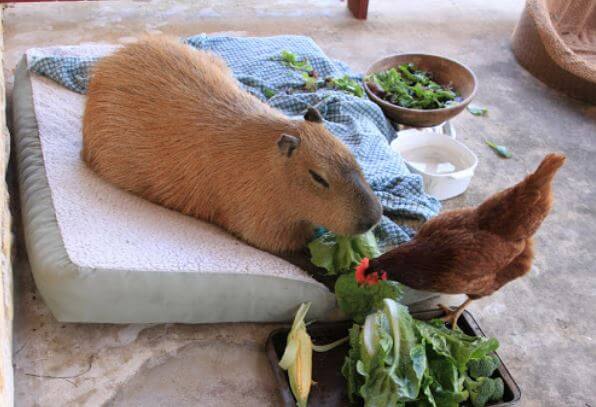
Much like humans and guinea pigs, capybaras do not naturally produce sufficient vitamin C in their bodies. Therefore, the pellets are fed to prevent diseases like scurvy, a vitamin C deficiency ailment.
Similarly, you can feed them vegetable diets such as carrots, apples, or may yams sparingly.
MUST KNOW: Why Are Capybaras So Friendly?
Capybaras can be addicted to sugar, and that may lead to selective feeding, which you don’t want to have in your hands. It is suggested that you should spread hay around their enclosures. This is likely to assist in recreating natural grazing patterns.
If you are certain there are no harmful weeds, fertilizers, or insecticides in the grasses, you can allow your capybaras to graze for as long as they want.
Monitor their excrement regularly. Their normal dropping is olive-shaped, and if it gets too loose, your pets are likely to be feeding on too much sugar or moisture, which may indicate adding more hay and roughage with fewer treats in their diets.
Health Problems With Capybaras
You should know the common ailments your pet may develop that can threaten their well-being as they grow and develop. Vitamin C deficiency diseases are their commonest challenges; luckily, they don’t have many others.
Like other rodents, capybaras are susceptible to respiratory infections and infestations by mites or lice in their fur. To guard against this, always ensure that their pens are kept clean. Should they become listless or stop eating voraciously, it indicates digestion problems.
We have discussed in great depth all the basic and mandatory requirements that you must know should you nurture the idea of house training the capybara, starting from their general behaviors, habitats, feeding habits, and lots more.
However, there are still other mandatory factors to consider, without which house training the animals will not likely be easy or even possible.
Am I Allowed To Own A Capybara?
This depends on where you live since it is legal to breed them at home in some places in the US, for instance, but illegal in others. Even though some states may permit raising the animal at home, some cities in those states may not.
In the US, many states do not allow breeding them, and to guard against contravening any state or city laws, find out from the local government authorities where you live whether you are allowed to keep them. You can never be too careful.
How Do I Get A Capybara For Breeding?
You can always get them from house training from local breeders around you. While making the purchase, you will discover that the females cost a little more than the males.
Before you buy a capybara, make sure that there is a qualified exotic veterinarian where you live who is experienced in these matters.
Be advised, though, that you should never take in a wild breed of capybaras because they cannot really be tamed, and also watch out for bald patches on their furs too.
Watch out for any lack of interest in physical activities to guard against buying a sick one or one with other underlying diseases.
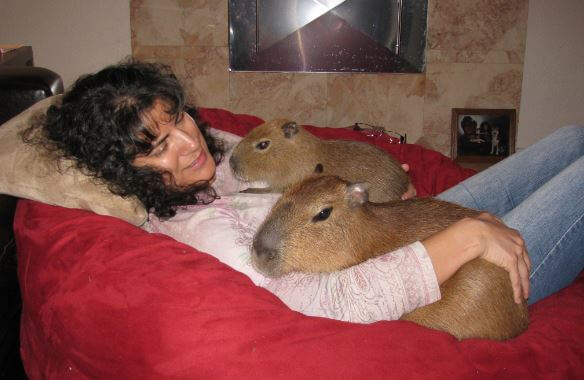
A healthy capybara should have soft fur devoid of any discolorations on its body. Some local breeders where you can get capybaras for sale are:
- Guinea Pig Species Profile.
- Patagonian Cavy Species Profile.
- Prairie Dog Species Profile.
What Is The Cost of Owning a Capybara?
Getting a baby capybara can be a really expensive enterprise indeed since it can cost anything from $1000, in addition to the costs of transportation, licenses, special permits, and setting up a suitable home for them. One significant avenue for heavy expenses is medical care.
You must locate a veterinarian around you who will treat their health issues if and when they develop them promptly. Take all of these into consideration, and you are likely to agree that keeping them at home is really not for average earners.
RECOMMENDED POSTS:
Conclusion
Capybaras are a social species and live in groups of 20 to 30 in their wild habitats and are also renowned for their intelligence. In fact, it is said that you can train them to walk on a leash and exhibit other awesome social behaviors.
However, as wild animals, they can be aggressive and exhibit their best behaviors when raised from childhood at home. Pet lovers all over the world cherish them for these traits. Raising them at home, therefore, demands specific care, making the idea difficult for ordinary people.
They are herbivores and feed on marshland and other forest grasses, tree barks, berries, seeds, or fruits. They also feed curiously on their feces occasionally, which is said to assist them with digestion.
For being semi-aquatic, they also need to swim every so often as well, and hence, they need to provide them with a pool. They roam frequently and therefore are not likely to do well in any confined space, making them quite destructive.
You must also know that they can very easily become sunburned. While rearing them at home, especially if they were brought young, they are likely to attempt still to eat their feces, and they also urinate and defecate in water, so expect a lot of cleaning while raising them at home.
If their teeth are not kept trimmed and long, it may cause them to feed less, which can lead to starvation and possibly early death as well. The article owes you this much information, as, without it, justice to the topic couldn’t be said to be done.
If you nurture the idea of keeping them at home at any time, either now or later, you will do well to read what we have here diligently. Have a great rearing of your awesome pet.



![Does Green Capybara New Species Exist?- [Answered] Green Capybara New Species](https://capybaratips.com/wp-content/uploads/2021/12/Green-Capybara.jpg)
